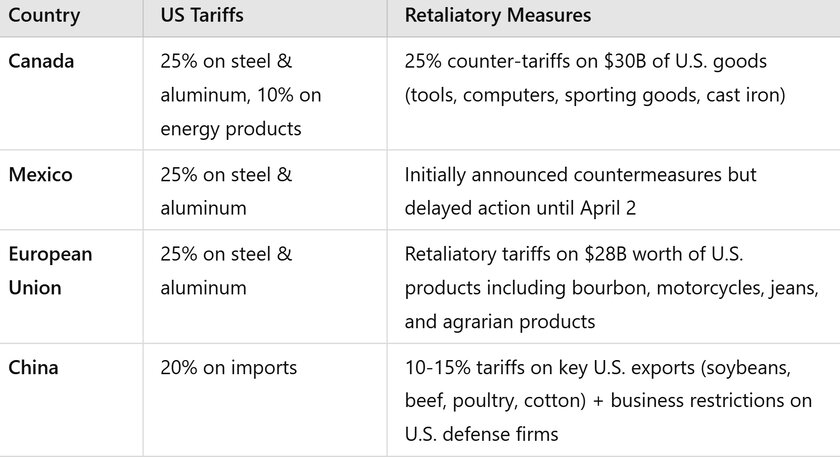The U.S. Tariff Trap: Who Wins, Who Loses?
Free Business Plan for Your Industry

Update on the "America First Trade Policy" by President Trump
In response to the White House's April 3, 2025, release of the updated America First Trade Policy (AFTP) report, the United States has implemented significant tariff increases targeting Chinese imports. On April 8, 2025, President Donald Trump amended an executive order to raise retaliatory tariffs on Chinese goods by 50%, resulting in a cumulative tariff rate of 104%. This action was taken after China imposed a 34% duty on U.S. goods, which itself was a response to earlier U.S. tariff announcements.
***BREAKING NEWS*** April 9, 2025: President Trump announced a 90-day suspension of all newly proposed tariffs—with the exception of those targeting China.
U.S. Defends Tough Trade Measures
The U.S. administration justified these measures as essential for national security and economic protection. Additionally, the executive order significantly increased duties on de minimis shipments—low-value goods under $800—from China. These tariffs are set to rise from 30% to 90% effective May 2, with the per-item postal fee increasing from $25 to $75, and further to $150 by June 1. Chinese online retailers such as Temu and Shein, which have utilized the de minimis exemption to ship inexpensive goods to U.S. consumers, are expected to be significantly impacted.
China Strikes Back: Retaliatory Tariffs of up to 84%
China retaliated by imposing combined tariffs reaching 84% on all U.S. imports. This escalation has led to significant volatility in global financial markets, with sharp declines in major indexes across Europe and Asia. Key sectors, including pharmaceuticals and automotive industries, have experienced substantial losses.
Transatlantic Tensions Rise as EU Targeted
The European Union has also been affected, with the U.S. implementing a 20% tariff on imports from the entire EU. In response, the EU is preparing countermeasures, including potential tariffs on U.S. products such as soya beans, clothing, and metal goods.
These developments underscore the intensifying global trade tensions following the AFTP report's release, with significant implications for international trade relations and economic stability.
25% Tariffs, 5 Countries, 1 Trade War: What’s Next?
The reintroduction of tariffs under President Donald Trump’s trade policies has once again ignited global trade tensions. The U.S. government has imposed 25% tariffs on steel and aluminum imports from multiple countries, alongside additional tariffs on Chinese goods (20%) and Canadian/Mexican imports (25%).
SWOT Up Your Business!
This move has led to retaliatory tariffs from affected nations, creating a ripple effect across industries, particularly impacting small businesses in the U.S. So far, only Australia has declared that it will not impose retaliatory measures against the steel and aluminum tariffs introduced by U.S. President Donald Trump.
Hint: Stay Strong, Spot Weaknesses, Seize Opportunities, Tackle Threats! Adapt to tariffs & keep your competitive edge with a SWOT-Analysis!
Potential Exemptions under USMCA
Under the United States-Mexico-Canada Agreement (USMCA), certain products qualify for tariff exemptions. The USMCA is a free trade agreement between the three countries, negotiated during Trump’s first term.
According to the White House, 38% of goods from Canada and about half of those from Mexico fall under the agreement.
However, there is uncertainty on how steel and aluminum fall under USMCA regulations. The U.S. government delayed enforcement on some items until April 2, but businesses remain unclear about long-term exemptions.
Which Industries Are Hit Hardest by Tariffs?
The new tariffs have widespread effects on various industries, increasing production costs and reducing global competitiveness for U.S. businesses. These are the key sectors impacted:
1. Automotive Industry
- U.S. car manufacturers like Ford and Stellantis face increased costs for steel and aluminum.
- Tariffs make vehicles more expensive to produce, potentially leading to higher consumer prices.
- Supply chain disruptions could slow down production and job growth.
2. Manufacturing & Machinery
- Small and medium-sized manufacturers, particularly those reliant on imported steel components, experience cost hikes.
- Toolmakers and industrial machinery producers face challenges in maintaining competitive pricing.
3. Agriculture & Food Industry
- Retaliatory tariffs from China and the EU hurt U.S. farmers exporting soybeans, poultry, beef, and cotton.
- The impact is particularly strong in Midwestern states, where farmers rely on Chinese and European markets.
4. Retail & Consumer Goods
- Higher costs for textiles, plastics, and household appliances affect small businesses and retailers.
- Imported jeans, motorcycles, and Bourbon whiskey (50% EU Tariff) are now more expensive in European markets, reducing demand for U.S. brands abroad.
5. Energy Sector
- Canada's 10% tariff on U.S. energy products impacts refineries and fuel distributors.
- This could lead to higher gas and electricity prices in some U.S. regions.
Trump’s Tariffs at a Glance

Frequently Asked Questions (FAQ) on Trump’s Tariffs
1. What are tariffs, and why does the U.S. impose them?
Tariffs are taxes on imported goods aimed at protecting domestic industries by making foreign products more expensive. Trump’s administration argues that these tariffs protect American jobs and reduce trade deficits.
2. Which countries have been affected most by Trump’s tariffs?
Canada, Mexico, the European Union, and China have been hit hardest. Canada is the largest supplier of steel and aluminum to the U.S., while China faces broader technology and agricultural trade restrictions.
3. How do tariffs affect small businesses?
Small businesses that rely on imported raw materials face higher costs. Additionally, export-oriented businesses struggle with retaliatory tariffs imposed by other countries.
4. Can small businesses get exemptions from tariffs?
Some products under the USMCA trade deal may qualify for exemptions, but details remain unclear. Companies must apply for product-specific exclusions, a process that can be time-consuming.
5. How do tariffs impact consumer prices?
Tariffs increase the cost of imported goods, leading to higher prices for cars, electronics, food, and household items.
6. Have Trump’s tariffs helped the U.S. economy?
While some domestic steel and aluminum producers benefit, most analysts predict higher inflation, slower growth, and negative impacts on manufacturing, agriculture, and trade-dependent businesses.
7. What happens if tariffs escalate further?
A prolonged trade war could lead to further economic slowdowns, affecting both businesses and consumers. The EU has left room for negotiations, but further U.S. tariffs on automobiles and tech products could lead to more aggressive countermeasures.
8. Where can small businesses get help with tariff-related issues?
Small businesses facing tariff ambiguities, exemption applications, or customs disputes can seek assistance from key institutions:
- U.S. Customs and Border Protection (CBP) – Provides guidance on tariff classifications, duties, and exemptions.
- Office of the U.S. Trade Representative (USTR) – Handles trade policies and tariff-related negotiations.
- Small Business Administration (SBA) – Offers resources and financial support for businesses affected by tariffs.
- International Trade Administration (ITA) – Assists businesses in navigating export regulations and trade barriers.
- National Association of Manufacturers (NAM) & Chamber of Commerce – Advocates for businesses impacted by trade policies.
For case-specific guidance, businesses can also consult customs brokers, trade attorneys, or industry-specific trade associations to navigate complex regulations effectively.
photo credit:
iStock.com/Jeffengeloutdoors.com



